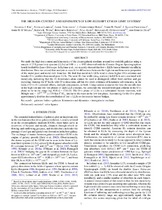| dc.contributor.author | Fox, Andrew J. | |
| dc.contributor.author | Lehner, Nicholas | |
| dc.contributor.author | Dave, Romeel | |
| dc.contributor.author | Tumlinson, Jason | |
| dc.contributor.author | Howk, J. Christopher | |
| dc.contributor.author | Tripp, Todd M. | |
| dc.contributor.author | Prochaska, J. Xavier | |
| dc.contributor.author | O'Meara, John M. | |
| dc.contributor.author | Werk, Jessica K. | |
| dc.contributor.author | Bordoloi, Rongmon | |
| dc.contributor.author | Katz, Neal | |
| dc.contributor.author | Oppenheimer, Benjamin D. | |
| dc.date.accessioned | 2017-07-17T13:43:28Z | |
| dc.date.available | 2017-07-17T13:43:28Z | |
| dc.date.issued | 2013 | |
| dc.identifier.citation | Fox, A. J. et al. (2013). The high-ion content and kinematics of low-redshift lyman limit systems. The Astrophysical Journal , 778 (187): 1-18 | en_US |
| dc.identifier.issn | 0004-637x | |
| dc.identifier.uri | http://hdl.handle.net/10566/3090 | |
| dc.description.abstract | We study the high-ion content and kinematics of the circumgalactic medium around low-redshift galaxies using a sample of 23 Lyman limit systems (LLSs) at 0.08 < z < 0.93 observed with the Cosmic Origins Spectrograph on board the Hubble Space Telescope. In Lehner et al., we recently showed that low-z LLSs have a bimodal metallicity distribution. Here we extend that analysis to search for differences between the high-ion and kinematic properties of the metal-poor and metal-rich branches. We find that metal-rich LLSs tend to show higher O VI columns and broader O VI profiles than metal-poor LLSs. The total H I line width (Δv 90 statistic) in LLSs is not correlated with metallicity, indicating that the H I kinematics alone cannot be used to distinguish inflow from outflow and gas recycling. Among the 17 LLSs with O VI detections, all but two show evidence of kinematic sub-structure, in the form of O VI-H I centroid offsets, multiple components, or both. Using various scenarios for how the metallicities in the high-ion and low-ion phases of each LLS compare, we constrain the ionized hydrogen column in the O VI phase to lie in the range log N(H II) ~ 17.6-20. The O VI phase of LLSs is a substantial baryon reservoir, with M(high-ion) ~ 108.5-10.9 (r/150 kpc)2 M ☉, similar to the mass in the low-ion phase. Accounting for the O VI phase approximately doubles the contribution of low-z LLSs to the cosmic baryon budget. | en_US |
| dc.language.iso | en | en_US |
| dc.publisher | The American Astronomical Society | en_US |
| dc.rights | Publisher retains copyright. Authors may archive the published version in their institutional repository. | |
| dc.source.uri | http://dx.doi.org/10.1088/0004-637X/778/2/187 | |
| dc.subject | Galaxies | en_US |
| dc.subject | Halos – galaxies | en_US |
| dc.subject | Kinematics and dynamics | en_US |
| dc.subject | Intergalactic medium | en_US |
| dc.title | The high-ion content and kinematics of low-redshift lyman limit systems | en_US |
| dc.type | Article | en_US |
| dc.description.accreditation | Department of HE and Training approved list | |

